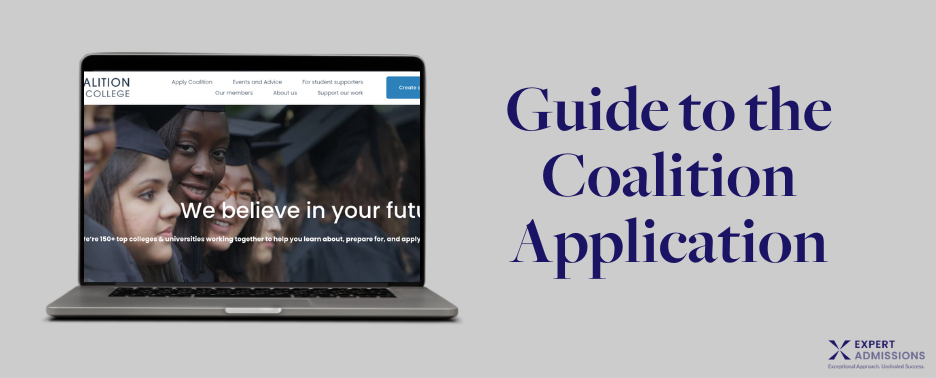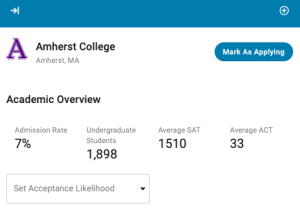
The Coalition Application streamlines the admissions process for high school students applying to college. While the Common Application is the most well-known and widely-used application system, the Coalition Application is known for its dedication only to including schools that provide a generous amount of need-based financial aid. You can find out more about the differences between the two systems here.
Recently, the Coalition Application has partnered with Scoir, a tool aimed at connecting students, their parents and counselors, high schools, and colleges for a better admissions experience. Through the new Scoir-Coalition interface, you can not only apply to college, but virtually tour campuses, take a “Find Your College Match” quiz, and compare schools on your list. So, the Coalition Application is not just for seniors, but for any high schooler wanting to know about undergraduate options.
Thanks to Scoir, applicants on the Coalition system can also view quick data and statistics for each college, such as acceptance rates, undergraduate enrollment, and average test scores.

Example data from the Scior-Coalition Interface shown in the image above
Over 160 public and private colleges across the US use the Coalition application, including many that also use the Common App. New members for the 2024-2025 application cycle include Yale University, Stanford University, Emory University, Boston University, and more. In order to join the Coalition, member institutions must meet certain criteria, such as a six-year graduation rate of at least 70%. The table below lists all of Coalition’s member schools.
| School |
|---|
| Allegheny College |
| American University |
| Amherst College |
| Arcadia College |
| Arizona State University |
| Babson College |
| Bard College |
| Barnard College |
| Bates College |
| Belmont University |
| Beloit College |
| Bentley University |
| Berea College |
| Birmingham University |
| Boston University |
| Bowdoin College |
| Brandeis University |
| Bucknell University |
| California Institute of Technology |
| Carleton College |
| Case Western Reserve University |
| Centre College |
| Chaminade University of Honolulu |
| Chatham University |
| Claremont McKenna College |
| Clark University |
| Clemson University |
| Colby College |
| Colgate University |
| The College of New Jersey |
| College of the Holy Cross |
| College of Wooster |
| Colorado College |
| Columbia University |
| Davidson College |
| Denison University |
| DePauw University |
| Dominican University of California |
| Drew University |
| Drexel University |
| Duke University |
| Duquesne University |
| Eastern Connecticut State University |
| Elmhurst University |
| Emory University |
| Florida Southern College |
| Franklin and Marshall College |
| Furman University |
| Hamilton College |
| Hanover College |
| Harvard University |
| Haverford College |
| High Point University |
| Hobart and William Smith Colleges |
| Hope College |
| Illinois College |
| Illinois Institute of Technology |
| Indiana University Bloomington |
| Ithaca College |
| John Carroll University |
| Johns Hopkins University |
| Kenyon College |
| Knox College |
| Lawrence University |
| Lehigh University |
| Le Moyne College |
| Loyola Marymount University |
| Lycoming College |
| Manhattanville University |
| Maryland Institute College of Art |
| Marywood University |
| Mercyhurst University |
| Miami University - Ohio |
| Michigan State University |
| Middlebury College |
| Mount Holyoke College |
| Mount Marty University |
| NC State University |
| Northeastern University |
| Northwestern University |
| Oberlin College |
| Occidental College |
| Oglethorpe University |
| Ohio Northern University |
| Olin College of Engineering |
| Pace University |
| Palm Beach Atlantic University |
| Pomona College |
| Portland State University |
| Princeton University |
| Quinnipiac University |
| Reed College |
| Rensselaer Polytechnic Institute |
| Rice University |
| Robert Morris University |
| Rowan University |
| Rutgers University - New Brunswick |
| Saint Michael's College |
| Skidmore College |
| Smith College |
| Southern Methodist University |
| St. John's College |
| St. Mary's College of Maryland |
| St. Mary's University |
| Stevens University of Technology |
| Stanford University |
| St. Olaf College |
| Stony Brook University |
| Swarthmore College |
| Syracuse University |
| Texas Christian University |
| Trinity University |
| Tufts University |
| Union College |
| University at Buffalo |
| University of Arizona |
| University of Chicago |
| University of Connecticut |
| University of Delaware |
| University of Florida |
| University of Idaho |
| University of Illinois at Springfield |
| University of Kentucky |
| University of La Verne |
| University of Maryland |
| University of Massachusetts - Lowell |
| University of North Carolina - Charlotte |
| University of Michigan |
| University of New England |
| University of Notre Dame |
| University of Oklahoma |
| University of Pennsylvania |
| University of Pittsburgh |
| University of Richmond |
| University of Rochester |
| University of San Francisco |
| University of South Carolina |
| University of Southern California |
| University of Tampa |
| University of the Incarnate Word |
| University of Vermont |
| University of Washington |
| University of Washington Bothell |
| Ursinus College |
| Vanderbilt University |
| Vassar College |
| Wake Forest University |
| Washington and Jefferson College |
| Washington and Lee University |
| Washington University in St. Louis |
| Wellesley College |
| Wesleyan University |
| Western Carolina University |
| Westminster College |
| Wheaton College |
| Whitman College |
| Willamette University |
| Worcester Polytechnic Institute |
| Yale University |
| Williams College |
| York College of Pennsylvania |
Like the Common Application, the Coalition Application allows you to fill out information about your background—including demographics, family, and education. Start by adding a college. The window for your first school will provide you with the sections you need to complete:
1. Personal
- Personal Information
- Contact Information
- Demographic Information
- Citizenship Information
2. Family
- Family Information
- Disaster Impact
3. Education
- High School Information
- Community Based Organizations
- College Information
- High School Coursework
- SAT/ACT
- English Proficiency Tests (if applicable)
- Honors & Distinctions
- Activities & Experiences
While it may seem like there are a lot of sections to complete, the Coalition App is user-friendly and intuitive. The instructions are straightforward and can help set you up well for a college application process that’s as stress-free as possible. However, it can be easy to mix up digits on a phone number or confuse the home address and school address prompts—so after you’ve filled out the boxes, review your responses before moving on.
Once you have added your information for one college, it will automatically transfer to all of the other colleges on your list that you apply to through the Coalition Application.
The Coalition Application Activities Section
In the Coalition App, you choose from a drop-down menu of categories:
- Academic
- Arts
- Club
- Family
- Sports
- Volunteer
- Work
- Other
The Coalition Application asks you to start by sharing the two experiences outside of your academic program that are most important to you. It also emphasizes that you should only share experiences and activities that have been “particularly meaningful.” As with the Common App, you can add up to a total of ten activities.
When considering which activities to include, think about the ones you’ve participated in the longest. Consider where you’ve had the most sustained involvement and leadership position. Even if you haven’t held an explicit leadership position, think about the commitments and communities where you’ve made an impact. Highlight about tangible achievements within your various extracurricular activities. Quantifiable data–such as the number of members you’ve recruited or the amount of money you’ve helped raise at a fundraiser–can succinctly help admissions officers understand the results of your hard work.
The Coalition Application also allows you to add up to five honors—including the title of the award, the grade in which you won it, and the level of the award (high school/local, state, district, regional/state, national, international). Alongside the activities list, adding your honors can help admissions officers understand your prowess in different fields inside and outside the classroom. You should list your most impressive awards and group any similar types of awards together.
Coalition Application Essay Prompts
- Tell a story from your life, describing an experience that either demonstrates your character or helped to shape it.
- What interests or excites you? How does it shape who you are now or who you might become in the future?
- Describe a time when you had a positive impact on others. What were the challenges? What were the rewards?
- Has there been a time when an idea or belief of yours was questioned? How did you respond? What did you learn?
- What success have you achieved or obstacle have you faced? What advice would you give a sibling or friend going through a similar experience?
- Submit an essay on a topic of your choice.
The six Coalition prompts are similar in many ways to the Common App’s Personal Essay prompts. When approaching the Coalition application essays, think about which prompt will give admissions officers the best sense of who you are and what you care about. While the suggested prompts serve as helpful brainstorming catalysts and provide you with ideas of what colleges generally look for, they’re not your only options. Think about who you are, how you spend your free time, and what matters to you. Don’t let the prompts restrict you! You might even start writing about what excites you and end up describing a time you had a positive impact on others. Or, you might write a completely different essay that doesn’t fit any of the pre-assigned prompts—in which case you ultimately have gone the “topic of your choice” route.
The Coalition Application not only allows you to apply to college—it offers a number of useful resources that can help you build your college list. Register for an account and explore the different options and search filters (by location, by majors etc.) to navigate the final steps of your list building. If you set aside time to explore how the app works and take your application process one step at a time, you should be set to take full advantage of all that the Coalition Application offers.
Leave a Reply